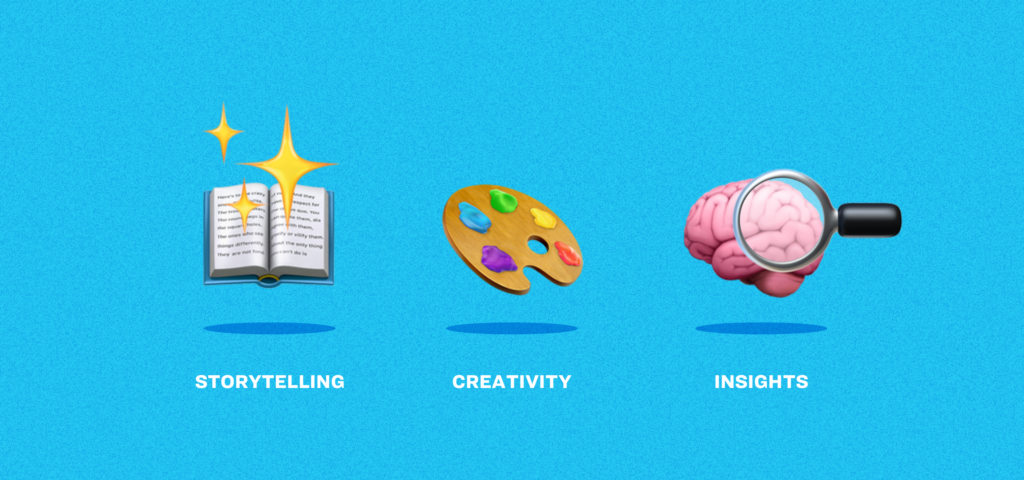Storytelling is a basic human need and a vital component of brand marketing. And for a long time blogs have been a central element in brand storytelling strategies — certainly for B2B brands, as well as many others.
But that time has come and gone. It’s time to retire the basic and outdated concept of blogs.
Does this mean you have to eliminate the blog section of your site? Absolutely not. You just have to rethink what you’re doing and what you want to get out of it.
Here’s why, and how.
No. 1: Focus on Storytelling, Creativity, and Deep Insights
Why? ‘Blogs’ have become synonymous with ‘content that is simple and routine to create.’ They have become a vector for creating content for the sake of creating content, and as a result, have simultaneously contributed to the general glut of digital content and devalued what the intent of blogging was in the first place: providing original perspectives and insights that you wouldn’t see anywhere else. The Catch 22 of generative AI is that, at least as far as ‘blogs’ are concerned, it is simultaneously easy to create a standard blog post and also completely useless because, in a time when anyone can enter a prompt to create a generically readable piece of content, that content has no purpose. Only something that will stand out from the crowd is worth creating, and that takes a high level of human planning, work, and creativity.
How: More than ever, it’s essential to have a clear and consistent editorial mission for the content you’re creating. At the individual post level, think about the lowest bar to clear for the topic you want to write about — say, a standard 500-word, text-only article — then burn that bar to the ground; ChatGPT owns that bar now, and you shouldn’t be (or have been) creating that anyway. Instead, think about something topically relevant that you read or watched recently and loved, and go create your own version of that. That means creating content with a fresh perspective and good design and something — be it entertainment or information — that makes it truly worth having spent time with. Not sure if you’re clearing that hurdle? If it was a joy (or a labor of love) to produce, it will probably be a joy to consume.
No. 2: Stop Betting on Search Traffic
Why? A lot of people got into the blog game because ‘Google rewards publishers,’ and ‘blogs are great for SEO.’ Both of those things can be true in a vacuum, but — especially over time — Google has increasingly rewarded editorially rich content, not ‘SEO-focused content.’ But more importantly, SEO is poised to undergo a massive shift with AI search engines that tell people the answer to their query and kneecap clicks to actual content. It’s a publisher’s armageddon (well, it’s one facet of the publisher’s AI armageddon). We don’t know yet exactly how that will play out, but it’s very possible that the ‘blog’ you maintain today will drive significantly less search traffic a year from now, and we may well be headed for a post-SEO world.
How: Just because your blog may not drive the search traffic it used to doesn’t mean it can’t still reach people. Explainer-style ‘how to’ and ‘what is’ topics might get eaten up in AI search, but that and other kinds of topics that once were SEO gold can still play on other platforms. People clicked on listicles in search results not because they showed up in search results, but because they were intriguing. That same content can entice on social, and we’ve seen this firsthand with Volt, our higher ed marketing news site. Several pieces of Volt content that have performed very well in search in recent months and years have also driven high engagement when we’ve posted them on LinkedIn in recent weeks. Does that mean you should crank out tons of listicles just to promote them on LinkedIn? Maybe — if they are well-researched, highly crafted, distinctive, and have genuine value to your audience.
No. 3: Stop Calling it a Blog
Why? The word ‘blog’ is derivative of ‘web log,’ and if that doesn’t tell you right away how dated this concept is, I’ll tell you that it comes from the late ‘90s. Calling your editorial content a ‘blog’ immediately signals to consumers that you are rooted in the late ‘90s — not to mention that seemingly every organization has a ‘blog,’ so if you’re calling your ‘blog’ a ‘blog,’ you’re saying ‘we have what everyone else has.’
How: But what is it if it’s not a ‘blog?’ It’s a storytelling hub. An editorial platform. An insights engine. A place for telling stories with care and creativity, for elevating your people and your purpose, for providing truly valuable insights and original research and distinctive observations. It should have a name that signifies as much. You could go with one of the newer ‘blog’ stand-ins like ‘insights’ or ‘stories,’ or you could go a step further and envision the editorial ecosystem in which the content that you are taking time and care to create will live and give it an expressive, brand-driven name for that platform.
Still Reading?
Here’s a secret: Not every company or institution needs a blog. For some, the distinct perspectives, creative insights, and analytical observations that a blog can provide come through in the very things they produce, and for others, telling such stories and conveying personality, creativity, or demonstrating expertise simply isn’t a priority. And that is more than fine (see: digital content glut).
Still, for many others, doing all of those things is still important. And it should be treated as such, like a purposeful mission to tell stories that can stop people in their tracks and that people will be glad they spent time with.
But calling those individual pieces of content ‘blogs,’ or the hub in which they live a ‘blog’ — and more importantly, thinking about them as ‘blogs’ — does a disservice to what you want to achieve with them.
Not all will agree, and if calling it a ‘blog’ works for you, okay. But for Pete’s sake, at the very least, stop thinking of it as just a blog.
Want to talk about creating valuable content in a changing digital world? Let’s talk.






